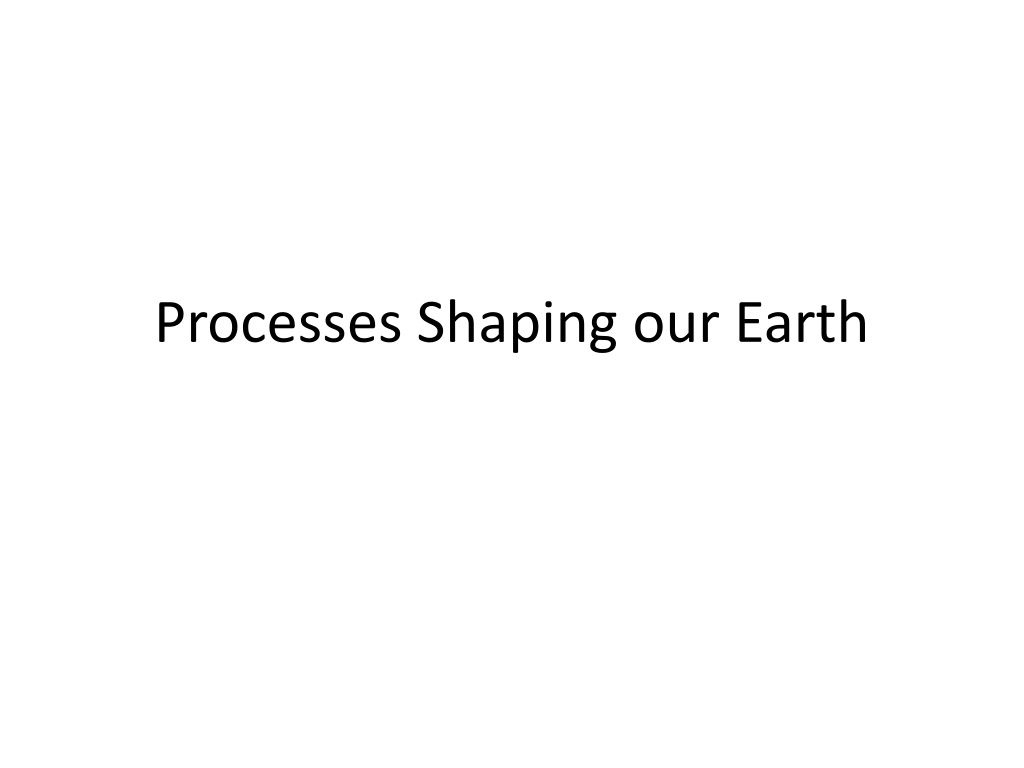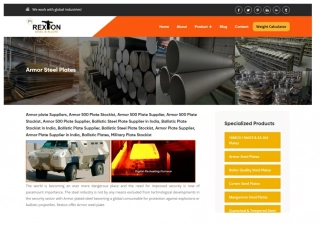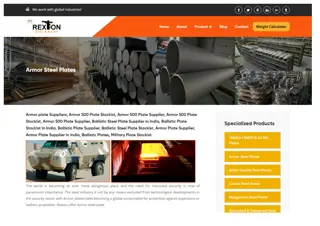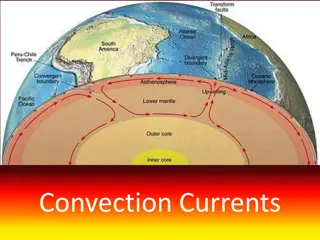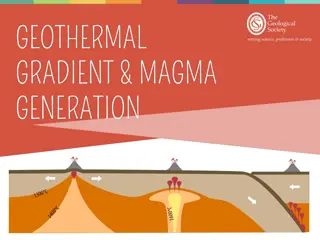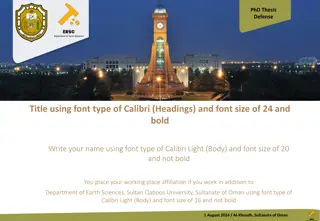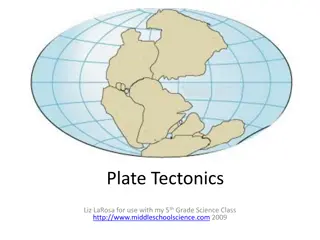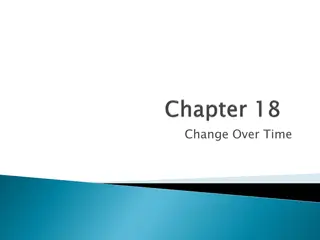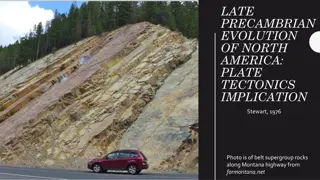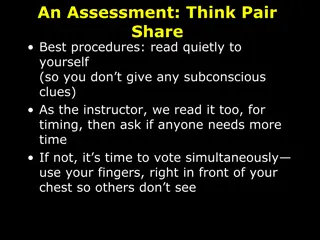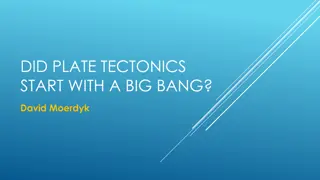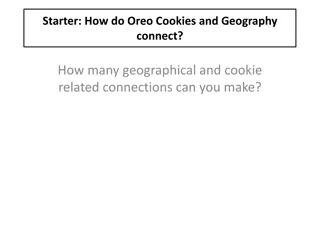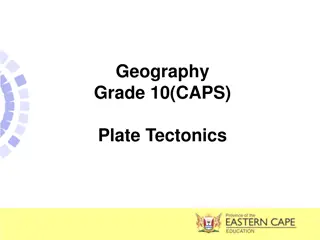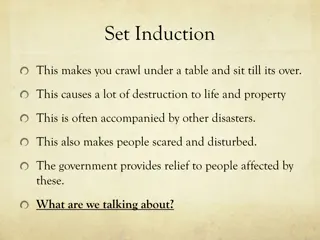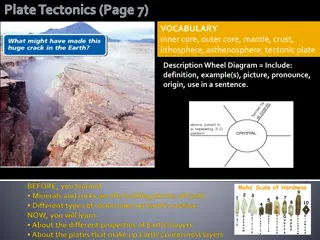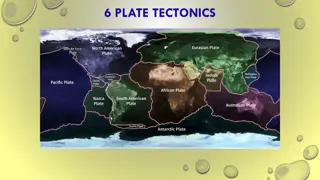Understanding Processes Shaping Earth: Lithosphere, Plate Tectonics, and Effects
Explore the components of our planet, such as the lithosphere, hydrosphere, atmosphere, and biosphere. Learn how the lithosphere, consisting of the Earth's crust and top solid mantle, interacts through plate tectonics, causing movements that shape the Earth's surface. Discover the concept of Pangaea and the factors driving plate movement, leading to phenomena like mountain building, seafloor spreading, rift valleys, earthquakes, and volcanoes.
Download Presentation

Please find below an Image/Link to download the presentation.
The content on the website is provided AS IS for your information and personal use only. It may not be sold, licensed, or shared on other websites without obtaining consent from the author. Download presentation by click this link. If you encounter any issues during the download, it is possible that the publisher has removed the file from their server.
E N D
Presentation Transcript
Four components of our Planet Lithosphere Hydrosphere Atmosphere Biosphere
Lithosphere Consists of the Earth s crust and the top section of solid mantle. Brittle uppermost shell of the Earth is broken into a number of tectonic plates. The movement of the plates shape the Earth s surface.
Plate Tectonic Motion The belief is that the Earth s lithosphere is divided into large slabs of rock known as tectonic plates. Earth s continents are attached to these plates. Scientists believe that these plates move as solid chunks floating on top of the more plastic part of the mantle. They only move a few centimeters each year.
What causes plate movement? Convection the spread of heat through the movement of fluid substance. Gravity contributes to plate movement. Brain Pop video over plate tectonics http://www.brainpop.com/science/earthsystem /platetectonics/
Effects of Plate Tectonics Mountain building Seafloor Spreading and Rift Valleys Earthquakes and Tsunamis Volcanoes
Mountain Building When two plates, known as continental plates, slowly push into each they fold upwards, creating mountain chains. This process has created the Himalayan mountains. http://www.geocraft.com/WVFossils/collision.html
Seafloor Spreading and Rift Valleys As the tectonic plates move apart they cause the seafloor to spread and magma will rise up and create a ridge of mountains. The separation of tectonic plates can also create rift valleys long valleys between parallel ridges of mountains.
Earthquakes and Tsunamis Plate movement can cause a break in the Earth s crust called a fault. Plate movements can also cause vibrations known as earthquakes. When the rocky crust breaks it will create a fault and sending vibrations known as seismic waves. The seismic waves are what scientist measure with a seismograph. When an earthquake occurs under or near the ocean it creates huge, destructive ocean waves known as tsunamis. http://www.pep.bc.ca/tsunamis/causes_2.htm
T S U N A M I S
Volcanoes A place in which tectonic plates go in different directions and sometimes one plate will dive under another and cause pressure in the Earth s mantle. A volcano can create lava when the magma reaches the Earth s surface. Most volcanoes and earthquakes locations match up with the plate boundaries.
RING OF FIRE An area where large numbers of earthquakes and volcanic eruptions occur in the basin of the Pacific Ocean
Weathering, Erosion, and Deposition also affect the lithosphere. Weathering the wearing down of rocks at the Earth s surface by the actions of wind, water, ice and living things Erosion process by which rock, sand, and soil are broken down and carried away. Erosion can cut a canyon like the Grand Canyon or carve away a region leaving valleys and lakes behind like the Great Lakes. Deposition particles and sediment can be deposited and build up by the same forces that erode. For example, ocean waves can bring sand to a beach.
Soil Soil is a mixture of several materials: sand, clay, rocks, water, fungi, bacteria, and decayed plants and animals. The type of soil affects the plant life. The deserts sands cannot support many forms of life. The soil in rainforests often lack nutrients because they are washed away. Soils in grassland areas and steppes or the best for farming.
Earths Landforms Mountains formed by collision of tectonic plates can be thousands of feet in elevation. Plateau flat highland whose sides drop suddenly. Valleys long, low areas between ranges of mountains, hills, or uplands. Often created by erosion, and may have a river or stream running along the bottom. Canyon deep gorge or ravine between cliffs, often carved from the landscape by a river.
Hydrosphere More than 70% of the Earth s surface is covered by water. Water Cycle The sun heats the surface causing some of the surface water to evaporate. Water vapor condenses into clouds. Water returns to the oceans and land as precipitation. Water on land and in the ground runs off into the oceans. And the process repeats.
Tides and Currents TIDES Tides are caused by the gravitational pull of the moon on Earth s ocean waters. High tide a time when sea levels are at their highest. http://www.brainpop.com/science/earthsystem/tides/ CURRENTS The movement of the ocean s waters. They occur at the ocean s surface and below. Surface currents are caused by the spinning of the Earth and winds.
ATMOSPHERE The envelope of gases around the Earth It is made up of 78% nitrogen and 21% oxygen. It absorbs solar radiation, moderates temperatures, and distributes water. WEATHER The conditions in the atmosphere closest to Earth, including humidity, winds, and precipitation (rain, snow, or hail). CLIMATE The average weather conditions of a place over a long period of time.
Geography of Weather Weather is affected by latitude, elevation, wind patterns, ocean currents, and mountain barriers. Temperatures are usually warmer closer to the Equator. Temperatures are cooler in higher elevations. Winds are based on the Earth s spin. Depending on the location winds can bring moist air and rain like monsoons or they can leave an area dry. Tropical hurricanes occur because the warm ocean water evaporates so quickly that it causes an area of low pressure.
Seasons The Earth tilts on its axis as it revolves around the sun. The tilt causes the sun s rays to hit the Northern hemisphere longer and more directly in summer than in winter. When it is summer in the northern hemisphere it is winter in the Southern hemisphere because the Southern hemisphere is tilting away from the sun and receives less direct solar rays. The two pole areas are very different. In the summer each pole has 24 hours of sunlight while in the winter the sun never rises in certain areas around the North and South pole.
Biosphere Refers to all life on Earth. Biomes distinct geographic regions with their own types of plant and animal life.
Types of Biomes Temperate Deciduous Forest Develop in areas with ample rain and moderate temperatures with cool winters. Trees change color in the fall and lose their leaves in winter. Tropical Rain Forest Develop in tropical areas near the Equator where there is ample rainfall and warm temperatures year round. Large trees form a canopy. Great abundance of animal and plant life.
Types of Biomes Grassland and Savanna or Steppes Grassland exists where the climate is drier and there is not enough rainfall to support large amounts of trees. Savannas are grasslands with a few trees. Deserts Regions that receive less than 10 inches of rainfall a year.
Types of Biomes Tundra Found closer to the polar regions. The ground is frozen most of the year.
